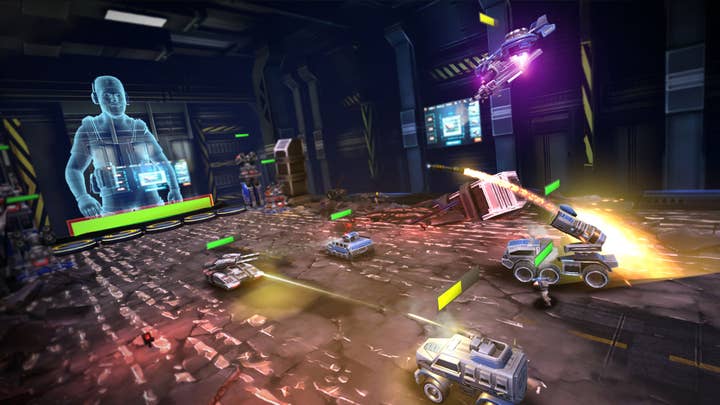Combatting asocial VR with asymmetrical multiplayer
Developer MunkyFun shares how the new League of War bridges the gap between virtual reality and couch players
For the most part, virtual reality is an isolating experience.
The headset blocks out all sight and sound of the real world in favour of the computer-generated environment players want to immerse themselves in. Interactions are almost entirely with NPCs, and often centre around shooting/slashing/punching them.
Even the software library appears to be primarily for the single player, with multiplayer titles unquestionably the minority (which given the limited install base for all current headsets makes sense). There are exceptions, of course, but by and large virtual reality developers seem to assume the end user is alone.
"It's mostly about attitude. We didn't come into this game trying to cram the rectangular box of an existing title into the round hole of virtual reality"
Mobile developer MunkyFun is one of the few studios determined to prove that virtual reality can bring people together - even if said people don't all own a headset. Late last year the studio released League of War: VR Arena, a virtual reality spin-off of its popular mobile strategy title exclusively on PlayStation.
While the game does, of course, cater to the single player with a campaign mode, perhaps the most interesting addition is the asymmetrical head-to-head multiplayer mode that sees VR players battle against any friends in the same room.
In virtual reality, one player physically deploys their army onto a tabletop-style battlefield using the motion controls. Their friend/opponent sees the action on the TV and uses the DualShock 4 to spawn their own troops and attempt to defeat the VR player's forces.
From the trailer, it appears there is little to no difference in terms of gameplay between the two - in fact, it almost undermines the use of virtual reality, inviting cynics to dismiss it as a gimmick. But MunkyFun stresses that the nature of VR vs TV makes this a difference experience for both players and has actively tried to capitalise on each set-up's strengths and weaknesses.

"A striking advantage that VR provides in terms of player input is the ability to target very precisely with your hand," CEO Nick Pavis tells GamesIndustry.biz. "We can all use laser pointers to point at things without really thinking about it, and that effortless targeting effect is emulated in the VR experience.
"It was not possible to implement targeting of that caliber with a regular controller, nor was the hands-on 'picking up units and putting them down' interface. As a result we decided to allow the DualShock controller player to rapidly select and deploy any available unit, and leave the AI to run a basic targeting program.
"The social player has a speed advantage, but the VR player has a targeting advantage."
Until virtual reality platforms attract a much larger audience, the best option for multiplayer remains local and MunkyFun maintains that this should ideally be asymmetrical. This ensures the two types of player receive a different experience.
You could argue that the very nature of having a headset on automatically makes the experience asymmetrical to those viewing the action on a screen, but some titles - particularly controller-based ones - offers much the same gameplay for VR players as they do their couch-perched partners. Paw Print's Bloody Zombies, for example, is a 2D brawler no matter which way you play it, although the VR player had a grander perspective of the battlefield in order to help uncover secrets.
Sony itself has experimented with asymmetrical multiplayer and the use of the TV as VR's 'social screen' in launch title PlayStation VR Worlds, but since then few developers have built upon the idea. It's a challenge, for sure, but Pavis believes this is the best way to create compelling experiences that really sell the social potiential of virtual reality.

"If you want a compelling gameplay experience for both the DualShock and the VR, asymmetrical gameplay is pretty much a given," he says. "A genuinely immersive VR experience isn't going to translate well to a 2D social screen, and a one-to-one translation of an otherwise interesting game on a 2D social screen isn't going to make for a compelling VR experience. If you're doing it right, VR vs social screen gameplay almost has to be asymmetrical.
He continues: "It's important to allow the couch player some level of interaction with the VR player's experience. At a minimum, a player-controlled spectator cam goes a long way towards including others in the game.
"Allow the couch player some level of interaction with the VR experience. At a minimum, a player-controlled spectator cam goes a long way towards including others in the game"
"Even better is to give the couch player something to do to complement the VR player's experience. Let them drop the bombs as the VR player pilots the plane. Give them the ability to spawn the zombies as the VR player runs around the cabin trying to board up the windows and find some ammo.
"Asymmetry between VR and couch play doesn't mean the couch player isn't having fun - it's an opportunity to add variety and replayability to the VR experience."
Even so, there are some who may argue that the limits of non-VR players' interactions with a VR experience makes such connections more of a novelty than an integral part of the game. Perhaps one of the easiest arguments to make against virtual reality as a whole is that, if done badly, the technology comes across as a gimmick rather than something genuinely unique and compelling.

It's a concern than no doubt plays on the mind of any VR developer, but the MunkyFun CEO says there's a simple ethos to adopt if you want to ensure your titles offers more innovation than illusion.
"It is an exciting time in VR because we are still in an experimental era where all ideas are good ideas"
"It's mostly about attitude," says Pavis. "We didn't come into this game trying to cram the rectangular box of an existing title into the round hole of virtual reality. We built League of War: VR Arena from the ground up as a VR experience first, taking apart everything about our League of War franchise and throwing it out the window to make it sing for the visceral nature of VR.
"Pushing buttons? No one wants to do that in VR. They want to grab their tanks and aim them at an enemy. To do VR right, you have to be thinking of VR every step of the way. Truth be told, the thing we were more worried about making the standard controller gameplay not come off as a novelty."
The virtual reality industry is in a tricky position. After all the hefty investments in the technology, high-end platforms like PSVR, Oculus and Vive have yet to reach the audiences many expected, making it much tougher to recoup development costs and fund further projects.
It's the polar opposite to the mobile market MunkyFun is accustomed to, with its ubiquitous devices and established practices for monetisation. Nevertheless, the developer is confident PSVR will deliver the audience it seeks for League of War: VR Arena. The device is by far the market leader, and introduces a new audience to MunkyFun's brand.
"I do not feel the VR market is well enough established for a developer to recoup development costs at this time," says Pavis. "Our game was a 'labor of love' for the team, and we are just happy to have been able to develop such a fun and entertaining product early on in the VR space.
He continues: "It is an exciting time in VR because we are still in an experimental era where all ideas are good ideas. It's not enough to drop users into an immense virtual world they must somehow move through - the lack of proper motion feedback as you fly, swim, or drive detracts from other visceral experiences that VR excels at, such as direct hand-eye coordination. I want to feel empowered by my VR setup, not restricted by it, and that is something I feel we nailed with League of War: VR Arena.
"Regardless of how locomotion issues pan out for VR gaming as a whole, the most important thing we've learned about VR is the importance of delivering a properly enhanced interface to the user's VR experience. The hardware is the new controller and the virtual world that you create for the player is your interface, and if you don't design with that in mind, you're not really designing for VR."
